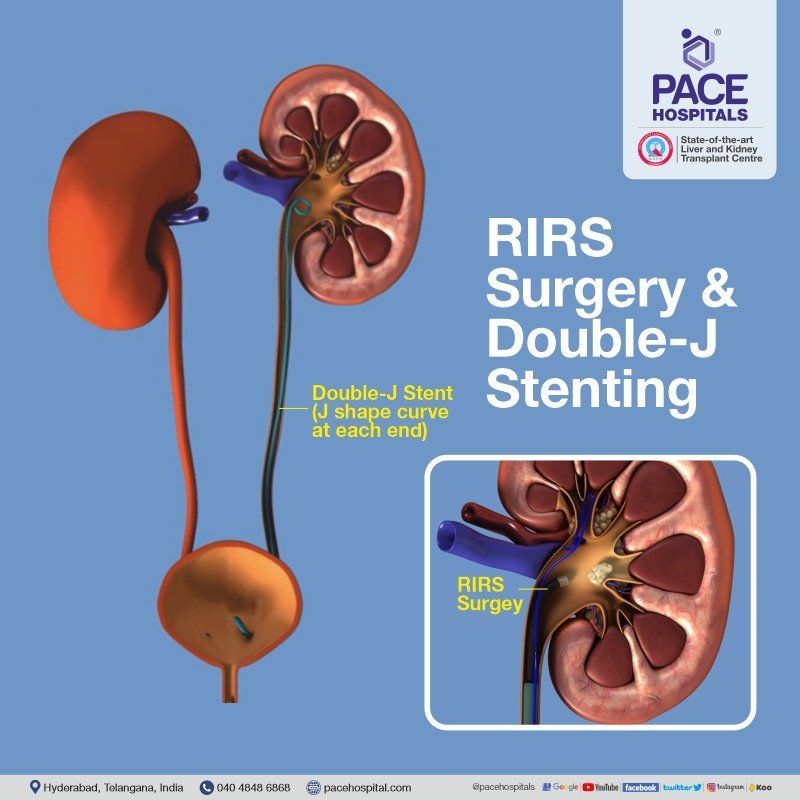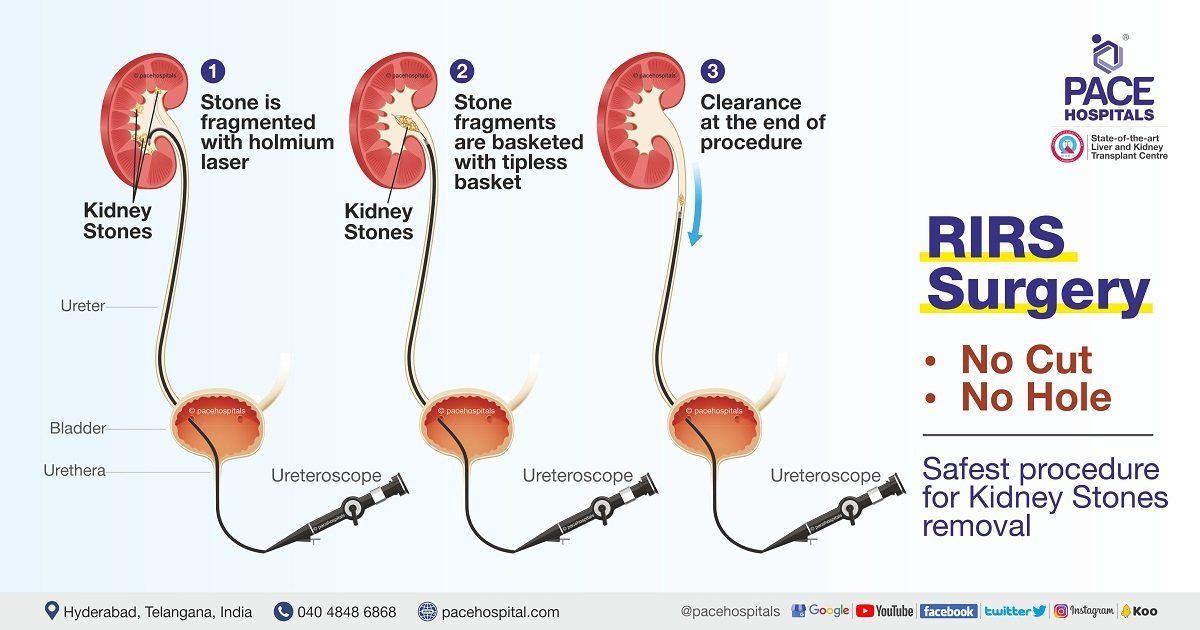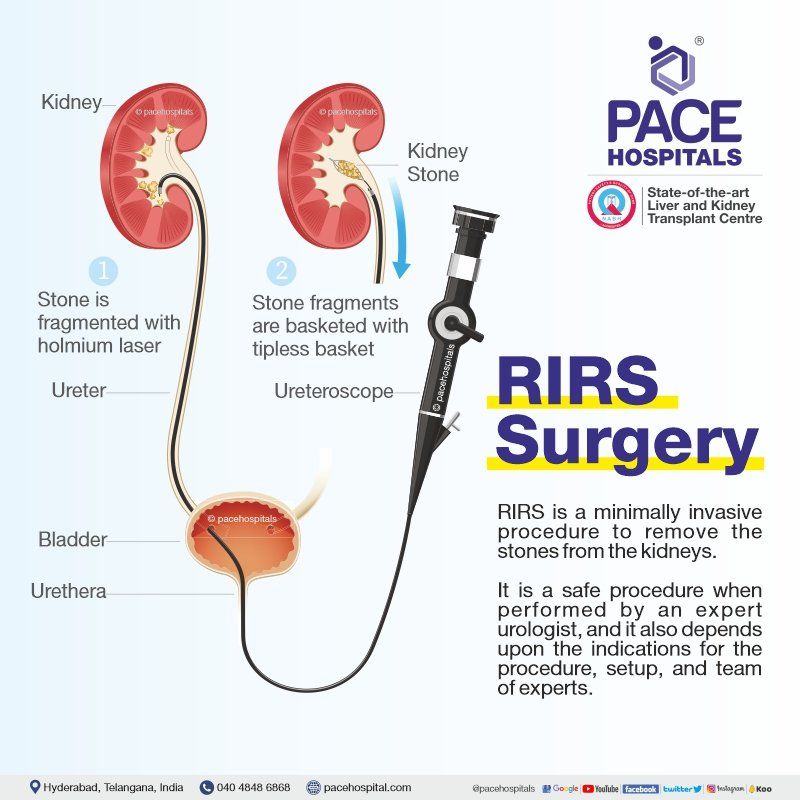RIRS Surgery - Procedure Indications, Side effects, and Benefits
At Pace Hospitals, the advanced OT is equipped with AI surgical robotic system and world-class 3D HD laser, laparoscopic equipment to perform minimally invasive major and supra-major surgeries.
Our team of the best urologist in Hyderabad and urology doctors are having extensive experience in performing RIRS Surgery.
Get Rid of Kidney Stones. Request an appointment for RIRS Surgery
RIRS Surgery - appointment
- Why choose us? -
7000+ RIRS kidney stone surgery performed
Team of best RIRS doctor with 30+ years of expertise
Cost-effective treatment with 99.9% success rate
All insurance accepted with No-cost EMI option
What is RIRS surgery and its purpose?
RIRS Full form in medical – Retrograde Intrarenal Surgery
RIRS is a minimally invasive procedure to remove the stones from the kidneys; during the surgery, a type of viewing tube known as a fiberoptic endoscope that is passed through the kidney. Because the fibre-optic is flexible, it may readily bend within the renal system and can easily enter the kidney and ureter.
The tube is inserted into the ureter, which is the part of the kidney that collects urine, and it helps in the visualization of various parts of the kidney. The narrow laser fibre is then passed through the scope, which breakdown stones into extremely fine particles to make it simpler to wash out with urine or saline irrigation.
The best aspect about the procedure is that there is no need for an incision, and the patient is given general / local anaesthesia. The urologist will execute the procedure to ensure that you receive the best possible care.
What are the uses or indications of RIRS Surgery?
RIRS (Retrograde intrarenal surgery) is a retrograde ureteroscopic technique, it is performed inside the kidney without the need for any external hole or cuts. With the use of a live X-ray, that is fluoroscopy, the device is pushed up through the urethra and then placed into the kidney. The process is minimally invasive, making it an excellent choice for treating difficult conditions. The following are some indications of RIRS Surgery:
- Kidney stones that are too large for lithotripsy
- Kidney stones in children
- Strictures in the kidney
- Bleeding disorders in the kidneys
- Failures in other treatment methods
- In obese patients
RIRS Surgery and DJ Stenting
DJ stent refers as Double- J stent, it is an urethral stent placed in the ureter with the J shape curve at each end, made up with polyurethane that prevent stent to slip in the kidneys and the bladder. DJ stent, usually placed before or after the RIRS surgery to relieve the pain caused by kidney stones or infection.
- Double-J Stent placement before RIRS surgery: In some patients based on their conditions, DJ stent is placed before the surgery to dilate the ureter and preparing the patient for surgery so that flexible ureteroscope can easily pass during surgery.
- Double-J Stent placement after RIRS surgery: In most of the patients, DJ stent is placed for 7 to 14 days that helps in healing and relieving the symptoms. Reinsertion of the DJ stent is not advisable generally in many cases.

There are some common problems associated with DJ stent placement such as Irritative bladder, Blood in urine, Urinary tract infection, Lumbar and Suprapubic pain, Intolerance and discomfort of stent. It is always advised to remove DJ stent sooner than later.
What to expect before a RIRS surgery?
A retrograde intrarenal operation (RIRS) is a simple, less invasive, and less likely to cause problems. Before Surgery, patient need to undergo these tests.
- Blood test
- X-ray KUB (Kidney, Ureter, Bladder)
- Pre-operative fitness from anaesthetist
In a few situations, pre-operative DJ stenting is required two weeks before the procedure; this stenting allows the ureteroscope to enter the kidneys more easily because the ureter is already dilated. Patients are kept 6–8 hours on an empty stomach before surgery.
What to expect during a RIRS surgery?
The patient will be sedated with anaesthesia, and the urologist will use a digital or fibre optic endoscope - a thin, flexible tube – to reach the bladder through the urethra and then to the kidney's urine storage area. The endoscope will detect stones and blast them with a laser until golden sand forms.
Furthermore, the DJ stent is to be placed for 1 to 2 weeks before or after the RIRS surgery, aids the smoothing and speeding of recuperation; in most cases, patients are discharged the next day following surgery.
What to expect after a RIRS surgery?
A urologist inserts a urinary catheter into the urethra to relieve pain and difficulty peeing; the catheter is left in place for 8 to 24 hours. After that, the patient will be shifted to the recovery room for monitoring for 6 to 8 hrs after the surgery. The patient will be taken to a hospital room to rest for at least 24 hours.
Furthermore, the patient must drink a large amount of fluids each day, at least 3 litres, in order to avoid infection and maintain urine output. In addition, if the patient is in good health and is able to resume normal activities the next day after surgery, he or she may be discharged. However, a follow-up with the primary care doctor is important.
Depending on your circumstances, urologist may provide you with additional instructions following the surgery.
Benefits of the RIRS Surgery
Retrograde intrarenal surgery (RIRS) is a unique and advanced way for treating renal stones. These are some of the following benefits of the RIRS surgery:
- Minimally invasive
- The procedure is simple and quick
- Less Recovery time is reduced
- Less pain
- Less morbidity
- Very minimal bleeding
- Harmless to the renal tissue

Risk factors / Complications of the RIRS surgery
RIRS surgery side effects are uncommon and only occur in a small percentage of instances. These are some complications reported in very less patients:
- Fever
- Flank pain
- Urinary infection
- Transient haematuria
- Acute urinary retention
- Fornix rupture
- Ureter avulsion
- Bleeding
- Sepsis
Frequently asked questions:
Is RIRS surgery painful?
Patients may not feel pain during RIRS surgery because it is performed under general anaesthesia. Post-RIRS surgery patients may have a little lower abdominal pain and discomfort that subsides within 18 to 36 hrs. Despite this, many individuals fear the RIRS surgery, the majority of people tolerate it well and recover quickly.
What is the difference between URSL and RIRS?
URSL is mainly for the lower ureteric stones if a stone size is less than 10 – 15 mm. if stone size is above 15 mm it is preferable to have laparoscopic treatment. RIRS surgery is an endoscopic procedure for proximal ureteric stones or stones in the kidney. If a stone size is less than 2 cm than RIRS surgery is used.
What is the difference between PCNL and RIRS?
PCNL is the percutaneous procedure where surgeon will puncture the calyceal systems of the kidney over the skin and approach the location of the stone usually this is related to stones present in the kidney calyceal system, though it is an endoscopic procedure we approach from the skin aspects, so it is called as percutaneous nephrolithotomy, usually this procedure is applicable to larger stones whereas RIRS is a complete endoscopic surgery where it is applicable for proximal ureteric or renal stones which are lesser than 2 cm in PCNL procedure patient will have a small incision to perform the surgery whereas in RIRS surgery there will not be any visible incision after the surgery.
How long does an RIRS surgery take?
RIRS surgery usually take 45 mins to 60 mins unless it is the redo procedure or complicated patient’s conditions further that may will take 90 mins to 120 mins (1 and 1/2 hours to 2 hours).
Can large kidney stones be removed by RIRS surgery?
No, it is not possible to remove large stones from the kidney in RIRS surgery, if a stone size is less than 2 cm rirs surgery is preferable.
How long does blood in urine appear after RIRS surgery?
It is completely normal to have small amount of blood in urine up to 7 days in case of urethral stent placed or up to 3 to 4 days in case of no stent, also person may notice pink, red or brown coloured urine.
In case of heavy bleeding or clots, a person should report immediately to primary care doctor or urologist.
Is there any food restriction immediately after RIRS surgery?
Yes, there is a food restriction after having RIRS surgery, to prevent the recurrence of stones in the kidney patient need to have healthy diet like limit animal protein, reduce oxalate from foods, reduce sodium consumption, get right amount of calcium from foods.
To know more: kidney-stones-diet-and-nutrition-guidelines-foods-to-avoid
What if RIRS surgery does not work?
In some cases due to technical issue RIRS surgery may not work in first setting, in such cases surgeon will undergo staged RIRS where a stent is inserted into the ureter and patient have to wait for 3 weeks for the ureter to dilated or adequate caliber so that the scope can easily enter into the ureter and even the pelvicalyceal system of the kidney.





